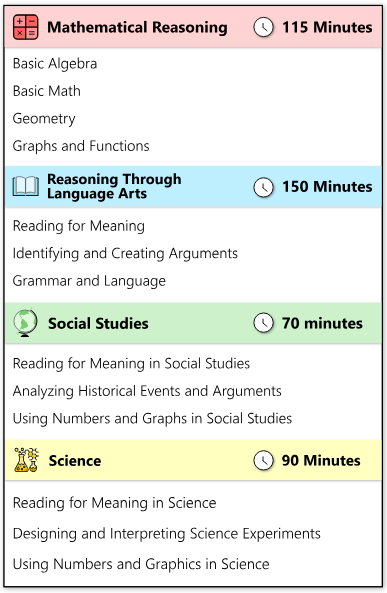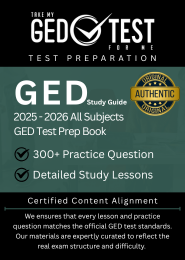GED Practice Test
Prepare for your GED without the pressure! This free GED practice test offers a stress-free way to sharpen your skills and build the confidence you need to succeed on exam day.
What is the GED Test?
The General Educational Development (GED) test is a standardized test in the United States designed for individuals who did not complete high school. Originating in 1942 to assist returning World War II soldiers, the GED now helps anyone without a high school diploma to earn credentials for career advancement or further education.
Accepted nationwide, the GED test takes about seven hours and is known for its accessibility and high success rate. Most US colleges and universities recognize GED certification, which has benefited over 20 million people. The test boasts a lower ratio of jobless people, a college admission rate of 60 percent, and general acceptance by workplaces and higher education at a rate of 97 percent.
Because of its roots in serving the American public, the administrative team that’s responsible for the GED test’s release caters to accessibility. Unfortunately, you cannot yet take the test in all 50 states (the test is not available in Iowa, Maine, or Tennessee). However, every resource you will need regarding the test—from the “when” and “where” to study guides—is made available online for your convenience.
Furthermore, while taking the GED is not free, there are flexible payment options to keep the test affordable to those who need it. The actual cost of the test differs depending on your home state.
There are four sections on the GED test:
- Reasoning Through Language Arts
- Math
- Science
- Social Studies
Questions are presented in several formats: short answer, multiple-choice, hot spot, fill-in-the-blank, drop-down, drag-and-drop, and extended response.

The social studies portion of the GED measures not only your ability to comprehend basic social studies concepts but consider them in the context of the real world. It has 50 questions in total. Each is tailored to fit one of four topics: economics, civics, geography, and US history. 15 percent of the text centers on economics, 50 percent on civics, 15 percent on geography, and 20 percent on US history. All of these subjects are common across United States high schools. In addition to the various question types you’ll be expected to answer, you will also have to justify many of your answers using reading passages provided to you.
Math
The math portion of the GED follows two subjects: algebra and mathematical quantities. In addition, your ability to reason is important. Based on what modern colleges are looking for among entering students, you will not receive any questions beyond basic mathematical concepts. However, you will be expected to fully comprehend the basics. 55 percent of the test covers algebra, and 45 percent covers problem-solving on a quantitative basis. When you take the test, you have the option to use both a TI-30XS scientific calculator and a digital calculator. However, you must bring the former on your own.
Science
The science part of the GED test seeks to measure your comprehension of scientific concepts. Each question you will find on this part of the test aligns with three scientific subjects: astronomy and Earth science, physics, and biology. These three subjects are not only the most taught in United States high schools but are considered to be the most suitable for adults in today’s world. 20 percent of the science test concentrates on Earth science, 40 percent on physics, and 40 percent on biological subjects. Approximately half of this part of the test comes with some sort of informational piece—be it a picture, a text passage, or something else—with three questions tied to them at maximum.
You won’t need a deep understanding of science to complete this particular test. Rather, every question will give you just enough context to be able to solve a question with just a rudimentary understanding of scientific concepts. You will not find questions about more in-depth subjects, such as energy or anatomy.
Language Arts
The language arts portion of the GED actually divides into two subsections: writing and reading. The aim of this portion of the test is to measure your contextual comprehension of the English language and English texts, and your writing and reading abilities. 25 percent of the test is prose and literature while 75 percent is nonfiction. American historical documents frequently appear on the nonfiction part of the language arts test. Each passage you read on the test ranges between 450 and 900 words in length.
The writing portion of the test, much like the social studies section, relies on your ability to provide evidence for your answers from the texts provided to you. The formatting of the test factors into the expectations surrounding your answers. Scorers want to see how well you can write on a technological basis—or, more simply put, how well you can type out your thoughts—and how well you can employ evidence to justify your written answers. The rubric you’ll be graded with additionally follows three rules: how well you can express yourself in English, how you organize and flesh out your ideas, and how well you explicate the readings and justify your answers.
The reading portion of the test is more “traditional,” and meant to measure your ability to comprehend what you read, as well as draw conclusions based upon evidence within the text. GED test takers are expected to be able to use the context of a sentence to determine vocabulary definitions, the main concept of a piece, and other elements.
Top 10 Most Challenging GED Questions
Now that you know more about the exam, try your hand at some targeted practice!
Over the last year, we’ve compiled the data from about 6,000 test-takers who tried their hand at the practice test at the top of this page. According to the data, around 80% of people answered these five questions incorrectly.
Answer each question and read through the answer explanation, whether you got the answer right or wrong. This will help you ensure you’ve got the topic mastered.
Whether you struggled with these questions or aced them on your first try, be sure to take the full practice test to get a better idea of how prepared you really are!
Get Your Daily GED Boost!
Receive a fresh GED practice question in your inbox every day to keep your skills sharp and your confidence growing.
GED vs. High School Diploma vs. HiSET
The GED, a high school diploma, and the HiSET are all credentials widely accepted by colleges and employers, but there are some notable differences among them.
Take a look at the details of each here:
GED Study Tips
How to Study Effectively
Your success on GED test day depends not only on how many hours you put into preparing, but also on whether you prepared the right way. It’s good to check along the way to see whether your studying is paying off. One of the most effective ways to do this is by taking GED practice tests to evaluate your progress. Practice tests are useful because they show exactly where you need to improve. Every time you take a free GED test, pay special attention to these three groups of questions:
- The GED questions you got wrong
- The ones you had to guess on, even if you guessed right
- The ones you found difficult or slow to work through
This will show you exactly what your weak areas are, and where you need to devote more study time. Ask yourself why each of these questions gave you trouble. Was it because you didn’t understand the material? Was it because you didn’t remember the vocabulary? Do you need more repetitions on this type of question to build speed and confidence? Dig into those questions and figure out how you can strengthen your weak areas as you go back to review the material.
Answer Explanations
Additionally, many GED practice tests have a section explaining the answer choices. It can be tempting to read the explanation and think that you now have a good understanding of the concept. However, an explanation likely only covers part of the question’s broader context. Even if the explanation makes sense, go back and investigate every concept related to the question until you’re positive you have a thorough understanding.
Comprehend Each Topic
As you go along, keep in mind that the GED practice test is just that: practice. Memorizing these questions and answers will not be very helpful on the actual test because it is unlikely to have any of the same exact questions. If you only know the right answers to the sample questions, you won’t be prepared for the real thing. Study the concepts until you understand them fully, and then you’ll be able to answer any question that shows up on the test.
Check out Our Free GED Practice Test Study Guide
It’s your complete GED prep solution. Packed with realistic practice questions and in-depth study lessons, it’s designed to help you understand every concept and confidently crush the exam.


Social Studies